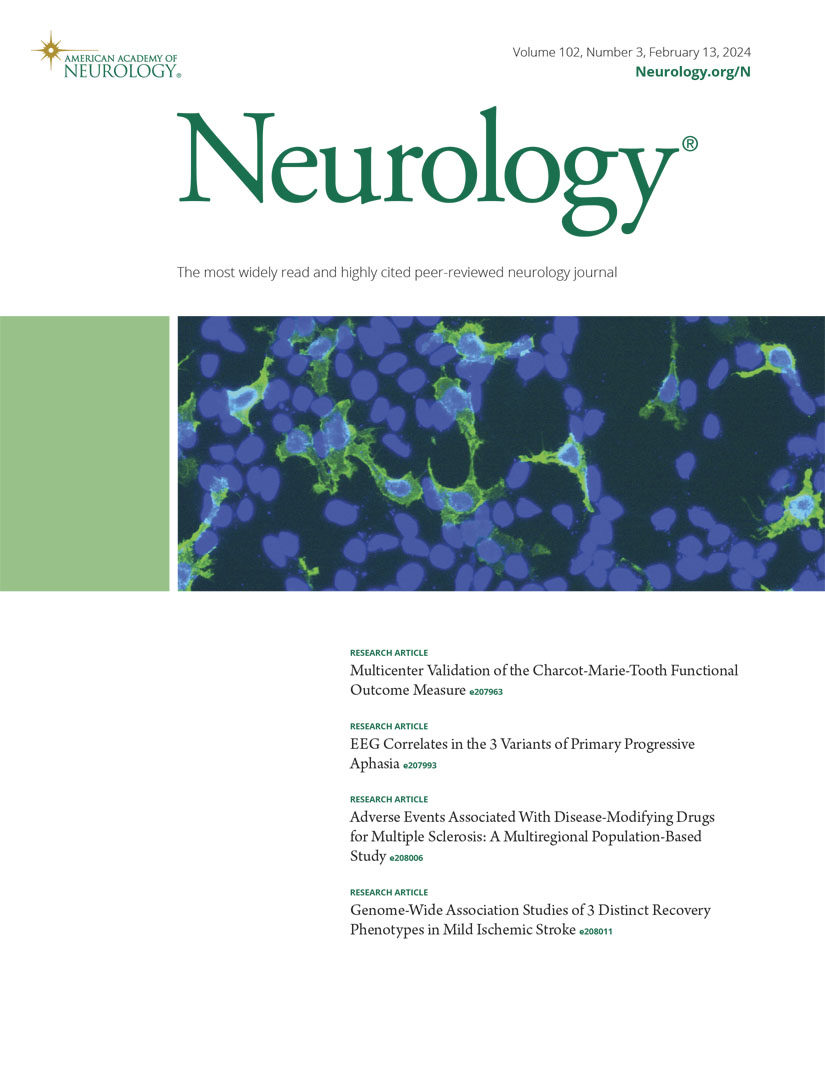美国成年人周围神经病变危险因素的种族和民族差异
IF 7.7
1区 医学
Q1 CLINICAL NEUROLOGY
引用次数: 0
摘要
背景与目的周围神经病变(PN)是一种病态疾病。在美国,非西班牙裔黑人和西班牙裔个体的PN患病率高于非西班牙裔白人。导致这种发病率增加的潜在机制尚不清楚。我们的目的是确定PN与种族/民族之间的关系;其他人口统计信息;以及代谢、生活方式和健康的社会决定因素(SDOH)的风险因素,这些因素来自美国的大量不同的成年人样本。方法对1999 ~ 2004年全国健康与营养调查进行横断面二次分析。PN采用感觉减少单丝试验评估。危险因素包括人口统计学(年龄、性别、种族/民族)、代谢(身高、体重、腰围、收缩压、高密度脂蛋白、糖化血红蛋白)、生活方式(身体活动、饮食)和SDOH(食品安全、家庭收入、健康保险)信息。结果本研究纳入8014人(55%为非西班牙裔白人,18%为非西班牙裔黑人,24%为西班牙裔,3%为其他)。平均(SD)年龄为60.8(13.3)岁,女性占50%。Logistic回归显示,非西班牙裔黑人(优势比:1.39,95% CI: 1.16-1.66)和西班牙裔(1.31,1.11-1.54)个体的年龄校正和性别校正后PN的几率高于白人个体。男性个体经年龄和种族调整后的PN发生率高于女性个体(0.55,0.48 ~ 0.63)。在调整代谢、生活方式和SDOH因素后,我们发现非西班牙裔黑人个体与白人个体的PN几率相似(1.17,0.93-1.46,p = 0.17),男性个体与女性个体的PN几率相似(0.83,0.66-1.05,p = 0.12)。然而,在调整这些综合危险因素后,西班牙裔个体保持更高的PN可能性(1.32,1.07-1.63,p = 0.001)。在个体危险因素中,我们发现年龄(1.05,1.04-1.06)、身高(1.03,1.02-1.05)、糖化血红蛋白(1.13,1.06-1.21)、腰围(1.011,1.005-1.017)和缺乏健康保险(1.49,1.16-1.92)与PN相关。在西班牙裔个体的分层分析中,我们发现饱和脂肪酸摄入的热量百分比(1.06,1.01-1.10)和食物不安全(1.48,1.06-2.05)与PN相关。讨论:我们发现,PN风险因素可能解释了非西班牙裔黑人中PN患病率较高的原因,而西班牙裔人群中则不然。我们还确定了SDOH的风险因素——包括没有保险,以及西班牙裔个体经历食品不安全——增加了PN的几率,这表明有SDOH风险因素的人需要筛查、预防和治疗PN。本文章由计算机程序翻译,如有差异,请以英文原文为准。
Racial and Ethnic Differences in Peripheral Neuropathy Risk Factors Among United States Adults.
BACKGROUND AND OBJECTIVES
Peripheral neuropathy (PN) is a morbid condition. In the United States, there is higher prevalence of PN in non-Hispanic Black and Hispanic individuals vs non-Hispanic White individuals. Underlying mechanisms driving this increased prevalence are unknown. We aimed to determine associations between PN and race/ethnicity; other demographic information; and metabolic, lifestyle, and social determinants of health (SDOH) risk factors in a large and diverse sample of adults from the United States.
METHODS
We performed a cross-sectional secondary analysis of the National Health and Nutrition Examination Survey from 1999 to 2004. PN was assessed using a monofilament test of reduced sensation. Risk factors included demographic (age, sex, race/ethnicity), metabolic (height, weight, waist circumference, systolic blood pressure, high-density lipoproteins, HbA1c), lifestyle (physical activity, diet), and SDOH (food security, household income, health insurance) information.
RESULTS
The study included 8,014 individuals (55% non-Hispanic White, 18% non-Hispanic Black, 24% Hispanic, 3% other). The mean (SD) age was 60.8 (13.3) years, and 50% were female. Logistic regression revealed that non-Hispanic Black (odds ratio: 1.39, 95% CI 1.16-1.66) and Hispanic (1.31, 1.11-1.54) individuals had higher age-adjusted and sex-adjusted odds of PN than White individuals. Male individuals had higher age-adjusted and race-adjusted odds of PN than female individuals (0.55, 0.48-0.63). After adjusting for metabolic, lifestyle, and SDOH factors, we found that non-Hispanic Black individuals had similar odds of PN to White individuals (1.17, 0.93-1.46, p = 0.17) and male individuals (0.83, 0.66-1.05, p = 0.12) had similar odds of PN to female individuals. However, Hispanic individuals maintained a higher likelihood of PN (1.32, 1.07-1.63, p = 0.001) after adjusting for these comprehensive risk factors. Among individual risk factors, we found that age (1.05, 1.04-1.06), height (1.03, 1.02-1.05), HbA1c (1.13, 1.06-1.21), waist circumference (1.011, 1.005-1.017), and lack of health insurance (1.49, 1.16-1.92) were associated with PN. In stratified analyses, among Hispanic individuals, we found that the percentage of caloric intake from saturated fatty acids (1.06, 1.01-1.10) and food insecurity (1.48, 1.06-2.05) were associated with PN.
DISCUSSION
We found that PN risk factors likely explain higher PN prevalence in non-Hispanic Black individuals but not among Hispanic individuals. We also determined SDOH risk factors-including being uninsured, and, in Hispanic individuals, experiencing food insecurity-increased the odds of PN, indicating the need for screening, prevention, and treatment of PN in persons with SDOH risk factors.
求助全文
通过发布文献求助,成功后即可免费获取论文全文。
去求助
来源期刊

Neurology
医学-临床神经学
CiteScore
12.20
自引率
4.00%
发文量
1973
审稿时长
2-3 weeks
期刊介绍:
Neurology, the official journal of the American Academy of Neurology, aspires to be the premier peer-reviewed journal for clinical neurology research. Its mission is to publish exceptional peer-reviewed original research articles, editorials, and reviews to improve patient care, education, clinical research, and professionalism in neurology.
As the leading clinical neurology journal worldwide, Neurology targets physicians specializing in nervous system diseases and conditions. It aims to advance the field by presenting new basic and clinical research that influences neurological practice. The journal is a leading source of cutting-edge, peer-reviewed information for the neurology community worldwide. Editorial content includes Research, Clinical/Scientific Notes, Views, Historical Neurology, NeuroImages, Humanities, Letters, and position papers from the American Academy of Neurology. The online version is considered the definitive version, encompassing all available content.
Neurology is indexed in prestigious databases such as MEDLINE/PubMed, Embase, Scopus, Biological Abstracts®, PsycINFO®, Current Contents®, Web of Science®, CrossRef, and Google Scholar.
 求助内容:
求助内容: 应助结果提醒方式:
应助结果提醒方式:


